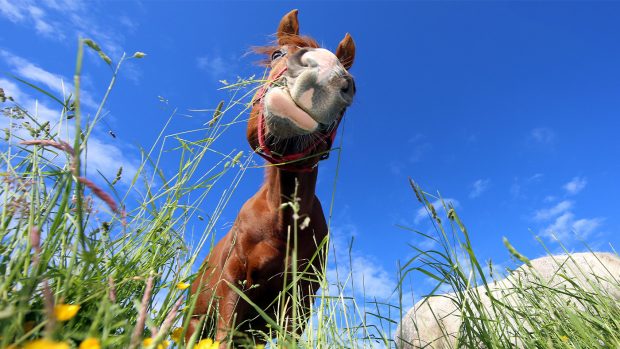Bio-availability
This refers to the ease with which nutrients can be absorbed from the digestive tract and utilised by the body.
Bioflavinoids
These are brightly coloured chemical compounds found in various fruits and other plant foods, which may act as antioxidants.
Chelation
A process by which minerals are “bonded” to short-chain proteins (amino acids) or carbohydrates, in order to improve absorption from the gut. Chelates occur naturally in the diet and are also known as organic proteinates or bioplex minerals.
Chondroprotective agents
These may help slow the degenerative processes of arthritis and encourage the regeneration of the synovial fluid and the cartilage matrix. They include glucosamine and chondroitin sulphate.
Cobalamin
Known as cyanocobalamin or vitamin B12, Cobalmin is necessary for carbohydrate, protein and fat metabolism.
Digestible energy (DE)
This is the estimated amount of calories contained in a feed or forage that can
be absorbed by the horse. These calories can be used for maintenance, growth or work. Any not used for will be turned into extra fat.
Digestive enhancers
These help improve and maintain a good bacterial population in the gut for efficient digestion. They are particularly useful for horses with compromised gut function such as those under stress — when travelling or competing, for example — or those with long-term worm damage or after a course of antibiotics. The term is generally used to refer to probiotics, prebiotics and yeast.
Energy-dense
A concentrated source of energy in a reduced volume of feed.
ERS (exertional rhabdomyolisis syndrome)
This is a type of tying-up, the expression is used to describe horses which suffer from the condition due to a genetic problem in the way they handle calcium at muscle level.
Essential fatty acids
Essential fatty acids (EFAs) are necessary for the formation of healthy cell membranes, the proper development and functioning of the brain and nervous system and for the production of hormone-like substances. They cannot be synthesised by the body from other fatty acids and must be obtained from food. There are two closely related families of EFAs: omega-3 and omega-6. Grass has a high omega 3:6 ratio, cereals do not; therefore if grazing is restricted it is important to ensure that the food is correctly supplemented.
Extrusion
In this form of cooking, the feed materials are ground into a flour and injected with very hot steam. The flour passes through holes, which can be of different shapes. The drop in pressure as the wet flour passes through causes the material to expand.
Gelatinisation#
This occurs when cereals are cooked. The heat ruptures the starch molecules, altering the structure and increasing the digestibility of the starch.
Glycaemic response
Foods containing carbohydrates are released as glucose into the bloodstream and stimulate the production of insulin and this is known as glycaemic response. Those high in starch, such as cereals, produce a greater glycaemic response than high-fibre feeds.
Glycogen
This is the main form of carbohydrate storage. Animals store surplus glucose as glycogen in muscles and the liver for use as energy when demand increases.
Hydroponic forage
Germinating barley seeds in lighted trays in a controlled humid environment produces barley grass, which is then harvested and fed, and this is known as hydroponic forage. It has a similar feed value to spring grass.
Immunomodulators
These are substances capable of modifying or influencing the functions of the
immune system.
Lysine
Proteins are the basic unit of animal tissues and are made up of 20 smaller units called amino acids. Some amino acids are essential and others are non-essential. Essential amino acids cannot be made by the horse’s tissues and must be supplied in the diet — lysine is one such essential amino acid.
Macro minerals
Nutrients needed for body structure, maintaining fluid balance, nerve conduction and muscle contraction, these are required in larger quantities (ie grammes per day).
Micro minerals
These are needed as components of “metalloenzymes” (enzymes that need a metal ion in their structure in order to work), which are involved in controlling many biological reactions. They are required in smaller quantities than macro minerals are (ie mg per day or less).
Malabsorption
The inability to absorb nutrients adequately from the intestinal tract. This may be a result of a previous worm infestation.
Multiple forage feeding
Research has shown that by offering horses a variety of different types of forage or fibre in their stable, they are able to spend more time foraging and eating, which are considered natural behaviours. This is thought to be beneficial for enriching the stabled horse’s environment and is particularly recommended for horses stabled for long periods.
Mycotoxin
The toxic chemical products formed by a few fungal species that can colonise crops and forages in the field or after a harvest and thus pose a potential threat to horses. Each mycotoxin is produced by one or more very specific fungal species. The absence of any visible mould does not guarantee freedom from toxins, as the mould may have died out while leaving the toxin intact.
Niacin
One of the B vitamins, niacin is especially important for digestion and appetite, as well as tissue and nerve cells.
Nutraceutical
A nutraceutical is a food or part of a food that provides medicinal or health benefits, including the prevention and treatment of disease. Legislation does not allow medicinal or health claims to be associated with feed. If manufacturers are describing a feed or feed component as medicinal they are breaking the law and increasing the likelihood that the ingredients will be banned from use.
However manufacturers can use the term ‘functional food’, which is food that provides health benefits beyond energy and essential nutrients (e.g. yogurt, which promotes beneficial microflora in the gut).
Panthothenic acid
Part of the B vitamin family, also known as vitamin B5, this is an antioxidant, water-soluble vitamin needed to break down carbohydrates, proteins and fats.
PSSM (polysaccharide storage myopathy)
A genetic form of tying-up, whereby horses have a glycogen storage problem in their muscles. These horses should not be fed starch nor sugar and 20-30% of their energy should come from fat. The rest of their diet should be fibre-based.
Pyridoxine
This is a B vitamin that assists in the function of specific enzymes within the body. These enzymes are involved in energy production and also the alteration of some of the building blocks of proteins (amino acids) to form specific compounds such as nerve transmitting substances.
Quality protein
This is a type of protein that contains a high proportion of essential amino acids and is therefore very digestible.
Threonine
An essential amino acid, Threonine is thought to be the second most essential (or vital), behind lysine.
Volatile fatty acids (VFAs)
Bacteria ferment the fibre in the horse’s hindgut and use it as a nutrient source
to grow and replicate. As they ferment the fibre, they produce substances known as VFAs. These are absorbed from the gut into the blood and taken to cells, where they are used at biochemical level to produce energy. This is time consuming and one of the reasons why the energy our horses obtain from fibre is considered slow-releasing.




